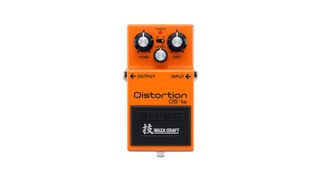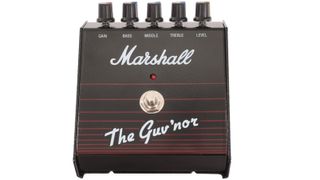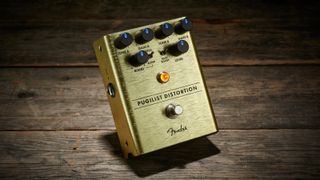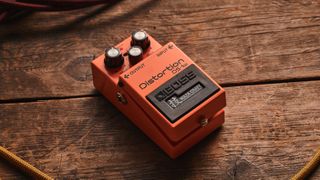Best distortion pedals 2025: our pick of the top gain stages for guitar
Bring the filth with 10 of the best distortion pedals for hard-rock, metal, and beyond

There’s nothing quite like stepping on a pedal and hearing the gritty growl of heavy distortion. Deforming your guitar signal to the point that it screams back at you is incredibly satisfying so whether it’s a searing solo, heavy power chords, or tight, high-gain riffing - at some point or another, you’re going to want to get the best distortion pedal on your ‘board.
Distortion pedals are a lot more versatile than you might think considering their reputation for total sonic destruction. You can use one to dirty up a clean amp, add extra saturation to a gain channel, or even replicate the sound of an entirely different amp, all from the comfort of your pedalboard. You don’t have to use them in a full-on way either, many of the pedals on this list will do sounds that are a lot more subtle.
Pretty much every guitar player has at least one distortion pedal on their pedalboard, but where do you begin with so much choice? It can be overwhelming when you’re starting from scratch, so that’s why we’ve put together this list of the best dirt boxes for your ‘board with top choices from Boss, MXR, ProCo, and many more.
We've included some in-depth buying advice at the end of this guide, where we answer the most frequently asked questions regarding distortion pedals. If you’d like to know more before you buy click the link, or keep scrolling to see the full product list.
Best distortion pedals: Our top picks
For pure value for money, you can’t do much better than the MXR Super Badass Distortion. Not only does it have an awesome name, but it boasts an excellent, musical sound, touch-sensitive dynamics, as well as a 3-band EQ for in-depth tone tweaking.
Coming in a close second - it just had to be - the world-famous ProCo Rat 2. Doing everything from a subtle drive to saturated distortion, right through to an almost fuzz-like tone. It’s an incredibly versatile box to have on your ‘board, and one of the most popular distortion pedals full stop.
Best distortion overall




Specifications
Reasons to buy
Reasons to avoid
If you’re going to name a pedal something as righteously cocksure as Super Badass, it better deliver some truly jaw-dropping tones. Thankfully, in this case, it does – offering plenty of distortion to cover most styles of rock and metal, with added versatility thanks to a three-band EQ which can sweep through throaty overdrives and into more scooped and metallic thrills.
With impressive touch sensitivity and low noise levels, finished in a retro silver, it’s a great all-rounder for just about any kind of gain seeker.
Read our full MXR M75 Super Badass Distortion review
Best on a budget




2. Pro Co Rat 2
Our expert review:
Specifications
Reasons to buy
Reasons to avoid
Though Kurt Cobain was more reliant on his Boss DS pedals, the Nirvana frontman was seeking something more extreme for Nevermind’s heaviest track, Territorial Pissings. He ended up using a blend of his Pro Co Rat distortion going straight into the Neve desk and his mic’d amp to unleash some of the highest levels of gain of their career.
The Rat’s trademark hard clipping comes from a pair of silicon diodes, which yield an aggressive yet smooth distortion, all with a hint of fuzz. That distinctive tone led to players as diverse as Thom Yorke, Robert Fripp, and James Hetfield all making good use of the rodent over the years.
This second version was released in 1988, and although the ’85 Whiteface RAT Reissue utilizes the original’s LM308 op amp and therefore captures the holy grail of Rat tones, the Rat 2 gets close on a budget. You may also want to check out our guide to the best fuzz pedals.
Best boutique distortion



Specifications
Reasons to buy
Reasons to avoid
If there’s any Marshall-inspired amp that’s sat among the top boutique options in recent years, it’s the Friedman BE-100. So, as you’d expect, its pedal version packs some gargantuan tones in one tiny box.
There’s an incredibly defined bite and increased output, and the tight control comes in very handy for a more defined attack. Then, of course, there’s that world-famous, irresistible vintage gain. Voiced after the greatest Plexis in Marshall history, the BE-OD, much like the head itself, oozes class and thunder on all fronts.
Read our full Friedman BE-OD review
Best for metal



Specifications
Reasons to buy
Reasons to avoid
Looking to ride the lightning like Kirk Hammett? Then you’ll be pleased to hear the Metallica lead guitarist’s signature distortion pedal is quite the beast indeed. It keeps noise down to a minimum thanks to the onboard gate, and also features a Doom knob to ramp up your low-end to earthquake-inducing levels.
The Hi/Lo switch allows users to go between rhythm and lead tones with ease, with additional high-end and sustain for those solos. The gain can be shaped through a treble control which covers an impressive range of sounds. Best of all, it’s moderately priced and the black and red finish is guaranteed to look slick on any pedalboard. Definitely the best distortion pedal for Metallica fans.
Read our full KHDK Dark Blood review
Best for rock

Specifications
Reasons to buy
Reasons to avoid
It’s a stone cold-classic, one that’s found pride of place on the ‘boards of players like Kurt Cobain, John Frusciante, and Steve Vai. The signature orange of the Boss DS-1W Waza Craft distortion pedal now has a long-awaited remake courtesy of Boss’ Japanese genii.
If you’ve ever used a Boss pedal before you’ll get an instant sense of familiarity when you pick this bad boy up, and it’s super easy to start dialing in distorted tones. Three controls for tone, level, and dist make it a breeze to adjust your sound, and that’s before we get to the mode switch.
It’s got two modes, Standard which gives you the classic, abrasive tone of a regular DS-1, and a brand new Custom mode which offers a more full-bodied, mid-emphasized sound. There’s a huge difference between the modes, so essentially your getting two-tone characters in one.
Most versatile




Specifications
Reasons to buy
Reasons to avoid
Founded by Brian Wampler in 2007, Wampler Pedals have made a big name for themselves over the last decade or so, with notable users including Neal Schon, Dweezil Zappa, Brad Paisley, and Rick Neilsen.
The Sovereign distortion pedal covers an array of dirts and distortions, with options for advanced gain and brighter modes. Then there’s the Mid Behaviour knob, which can take you from a metallic scoop to much more classic and thicker-sounding heavy tones. The best distortion pedal if you want something that feels more unique and boutique.
Read our full Wampler Sovereign Distortion review
Best dual distortion





Specifications
Reasons to buy
Reasons to avoid
As well as its dual gain engines (A and B), the Pugilist also boasts a blend knob for a mix of both – which makes it one of the most versatile distortion pedals out there. Especially considering each engine has its own adjustable gain and tone controls, it can function almost like three different channels at once.
As you’d expect, the A channel is a milder, more rhythmic kind of distortion, while B brings more saturation and sustain for leads. And, of course, running both together offers no end to the amount of gain you can dial in. Housed in an elegant brushed gold casing, here’s one for the thrill-seekers, and for beginner guitarists looking for an affordable pedal.
Read our full Fender Pugilist Distortion review
Best old-school distortion




Specifications
Reasons to buy
Reasons to avoid
Based in Oklahoma and founded in 2011, Walrus Audio is another brand whose pedals have really made an impact in a relatively short space of time. This updated version of their Iron Horse distortion will undoubtedly be popular among those looking for thicker and sludgier tones, with no shortage of low-end and warmth.
It offers three distortion modes operated by a toggle switch that changes between different clipping diodes, providing more versatility in shaping the tone of the distortion. Depicting an armored horse riding into battle against a Galaxy Gold finish, here’s a pedal that’s undoubtedly victorious in both looks and tones.
Read our full Walrus Audio Iron Horse review
Best one-knob distortion


9. EarthQuaker Devices Acapulco Gold
Our expert review:
Specifications
Reasons to buy
Reasons to avoid
When it comes to distortion pedals, they don't come simpler than the Acapulco Gold by stompbox trailblazers, EarthQuaker Devices. This gilded pedal is designed to give you the sound of a Marshall-style amplifier being pushed to breaking point - the sound of rock n roll.
The single giant knob controls the pedal's output volume, leaving the tone shaping up to you and your guitar. To achieve bluesy breakup, simply turn the volume down on your guitar, and to melt faces turn it up to the max.
While this pedal may not be the most flexible when compared to the likes of the Wampler Sovereign Distortion with its switches and mid-control, there's something to be said about a straightforward pedal that nails the sound it's going for.
Best amp-like distortion

10. Marshall Guv'nor
Our expert review:
Specifications
Reasons to buy
Reasons to avoid
It's fair to say the Guv'nor is now a modern classic. Hailed as one of the first true amp-in-a-box distortion pedals, this fierce stompbox is beloved by many players of varying genres.
Originally released in 1988, this pedal provided guitarists with the sound of a fully cranked stack at the click of a button. Since then, the pedal has developed a cult following, which has led players to beg Marshall to reissue the cherished unit - well, we're happy to report they finally listened!
This new version is very bit as good as the original - if not better - delivering the warm, saturated tone the odd shaped pedal is known for.
FAQs

For many gigging musicians, the trusty distortion pedal is the most crucial stompbox on the board, especially when using backline amps provided by the venue. Most guitar players have arrived at a show, only to find a less than desirable amp waiting for them on stage - a Fender Twin to play metal springs to mind - a distortion pedal is quite possibly the only thing that's going to save you, in that situation.
So, let's break down what to look for when choosing the best distortion pedal for your needs.
What is a distortion pedal?
A distortion pedal is a device used to dirty up your guitar signal. These stompboxes use 'hard-clipping' to transform your guitar tone from a timid clean sound to an epic assault of hard rock goodness.
As you'd expect, there are several different flavors of distortion out there. From transparent gain pedals that retain the guitar and amp characteristics to pedals that will transform your rig into something completely unrecognizable, there's a wide range of distortion pedals on the market for everyone.
With all gain pedals, there is a significant crossover between overdrive pedals, fuzz pedals, and distortion - at the end of the day, they are shades of the same type of effect. Now, which is suitable for you is really a matter of taste. Fans of metal will enjoy a pedal with a bright and pronounced attack - and a built-in noise gate wouldn't go a miss - whereas those that play grunge or other lo-fi styles generally prefer the grittiness of a distortion that leans more towards the fuzz side. If you're feeling more adventurous, stacking both kinds on top of an already overdriven amp can yield some pretty fantastic results.
What do I look for in a distortion pedal?
When trying to choose the best distortion pedal for you, the first thing to consider is functionality. Perhaps you're looking for something with several gain stages, almost like channels on an amp. In that case, there are numerous options out there that will allow you to switch between two gain sounds, and in some cases, stack them. Maybe you're looking for something simple? Well, there are more single-button distortion pedals out there than you can shake a stick at.
The next important factor is the general shape of the distortion - and no, we don't mean the shape of the actual unit, but rather the sound of the distortion itself. If you’re after something more vintage-voiced, then Bogner and Friedman are solid options for you. If you need a more modern sound, then the Mesa/Boogie Throttle Box and Kirk Hammett's signature Dark Blood offer truly outstanding contemporary gain sounds.
Among our choices, you'll find multi-channel offerings, blendable drives, and amp-inspired circuits at a variety of price points.
Where does my distortion pedal go in the chain?
For the most part is better to put distortion pedals earlier in the chain, usually stacked after your overdrive or boost pedals. We say this a lot, but there are no rules to this. Many guitar players have used distortion pedals after reverbs to create huge swathes of sound for example. Another classic use is the Boss HM-2, where you run it into the effects loop to push your amp harder.
Which distortion pedal is best for metal?
Typically you’ll be using a distortion pedal for heavier styles of music, and it’s a common question to ask which is best for metal. We’d say it all depends on your particular genre of metal. There are a lot of different styles of metal and thus, a lot of different tones. So have a look at your favorite guitarist's pedalboard and see what they’re using for more inspiration.
With the right amount of tweaking, pretty much any of the distortion pedals on this list will get you a great sound for metal. A lot of players feel they need to dime all of the knobs to get a great metal tone, but the truth is reigning it back a bit can really help with clarity and ‘tight’ sound, so be careful with the gain knob.
A classic trick for metal tone is to ‘scoop’ the mids, and a lot of pedals have this naturally built into their EQ sections, but again be careful. Taking out too much mid-range can result in your tone getting lost, particularly when you’re playing with another guitarist in a full-band scenario.
How we choose

Here at MusicRadar, we are experts in our field, with many years of playing, creating and product testing between us. We live and breathe everything music gear related, and we draw on this knowledge and experience of using products in live, recording and rehearsal scenarios when selecting the products for our guides.
When choosing what we believe to be the best distortion pedals available right now, we combine our hands-on experience, user reviews and testimonies and engage in lengthy discussions with our editorial colleagues to reach a consensus about the top products in any given category.
First and foremost, we are musicians, and we want other players to find the right product for them. So we take into careful consideration everything from budget to feature set, ease of use and durability to come up with a list of what we can safely say are the best distortion pedals on the market right now.
Find out more about how we test music gear and services at MusicRadar.
Related buyer's guides
MusicRadar's got your back
- Bring the power with the best pedalboard power supplies
- Add depth to your sound with the best reverb pedals
- Still haven't found what you're looking for? Try one of the best delay pedals
- Looking for the ultimate 80's tone? You'll need one of the best chorus pedals
- Get every sound you want in one place with the best multi-effects pedals
- Best guitar effects pedals: our pick of effects in every pedal category
Get the MusicRadar Newsletter
Want all the hottest music and gear news, reviews, deals, features and more, direct to your inbox? Sign up here.
Mike is Editor-in-Chief of GuitarWorld.com, in addition to being an offset fiend and recovering pedal addict. He has a master's degree in journalism, and has spent the past decade writing and editing for guitar publications including MusicRadar, Total Guitar and Guitarist, as well as a decade-and-a-half performing in bands of variable genre (and quality). In his free time, you'll find him making progressive instrumental rock under the nom de plume Maebe.
- Matt McCrackenJunior Deals Writer
- Daryl RobertsonSenior Deals Writer

NAMM 2025: “Morph across the spacetime spectrum”: Pigtronix unveils the Cosmosis I, shrinking its smash-hit ambient reverb into a compact single-footswitch pedal

NAMM 2025: “Guitarists can fully capture the essence of their favorite guitar gear without owning the physical hardware” – Has Mooer captured the amp profiling market with the GS1000?